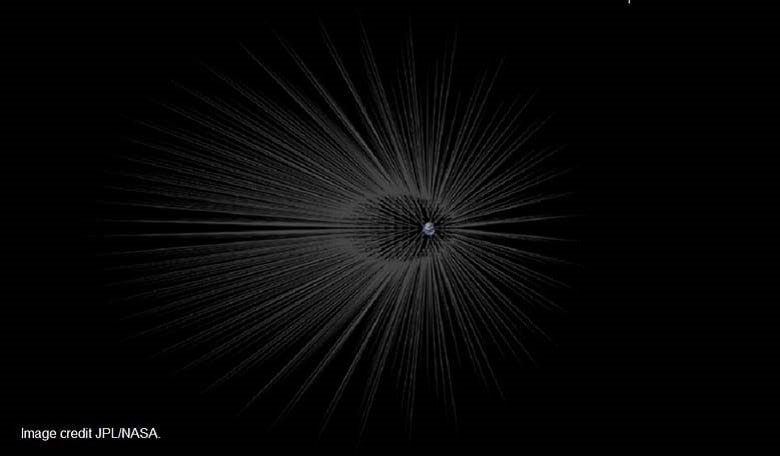Dark matter, the elusive substance permeating the Universe, that has remained undetected since it was first proposed over 30 years ago, may yet prove to be stranger than originally thought. In new research conducted by Gary Prézeau of NASA's Jet Propulsion Laboratory, Pasadena, California and published this week in the Astrophysical Journal, Prézeau suggests that a stream of dark matter particles is focused into an ultra-dense filament, or "hair" when it encounters an object such as a planet. In this case, many such hairs should be sprouting from Earth already.
According to simulations performed in the last decade, dark matter, which makes up about 27 percent of all matter and energy in the Universe forms "fine-grained streams" of particles that move at the same velocity and orbit galaxies such as ours. According to Prézeau's simulations, when dark matter encounters a planet like Earth, its gravity would focus and bend the stream of dark matter particles into a narrow, dense hair.
Not only that, but like the hairs on your head, dark matter hairs that emerge from a planet would have both ‘roots’ and ‘tips’ meaning they are denser at one end of the hair compared with the other. The root of the hair for example should be around 600,000 miles (1 million kilometers) away from the surface (of Earth), or twice as far as the moon and the density of the dark matter stream is about a billion times more than average. Conversely the tip of the hair is thinner, less dense and is about twice as far from Earth as the hair's root.
"A stream can be much larger than the solar system itself, and there are many different streams crisscrossing our galactic neighborhood," says Prézeau. "If we could pinpoint the location of the root of these hairs, we could potentially send a probe there and get a bonanza of data about dark matter.”
Finding the location of the roots could be made easier by observing larger planets, as according to Prézeau's simulations, a stream of particles passing through Jupiter's core would produce even denser roots – almost 1 trillion times denser than the original stream.
This is in deep contrast with ordinary matter, the stuff which makes up everything else we can see around us and equates to only 5 percent of the rest of the Universe. Galaxies, which contain stars made of ordinary matter, form because of fluctuations in the density of dark matter. Gravity acts as the glue that holds both the ordinary and dark matter together in galaxies. Nonetheless, as neither dark matter nor dark energy, a strange phenomenon associated with the acceleration of our expanding universe, has ever been directly detected, locating the roots of dark matter hairs would be a good place to look, given how dense they are thought to be.
An offshoot to Prézeau’s simulations is the possibility of using dark matter hairs to infer density changes in planets. Earth, for example has many discontinuities as you pass from the inner core to the outer core, similarly density changes can occur on icy moons due to deep oceans. Such changes of density would be reflected in the hairs and would show as ‘kinks’ that correspond to the transitions between these different states in density - another possible mechanism for deciphering the make-up of an exoplanet or its moon.











